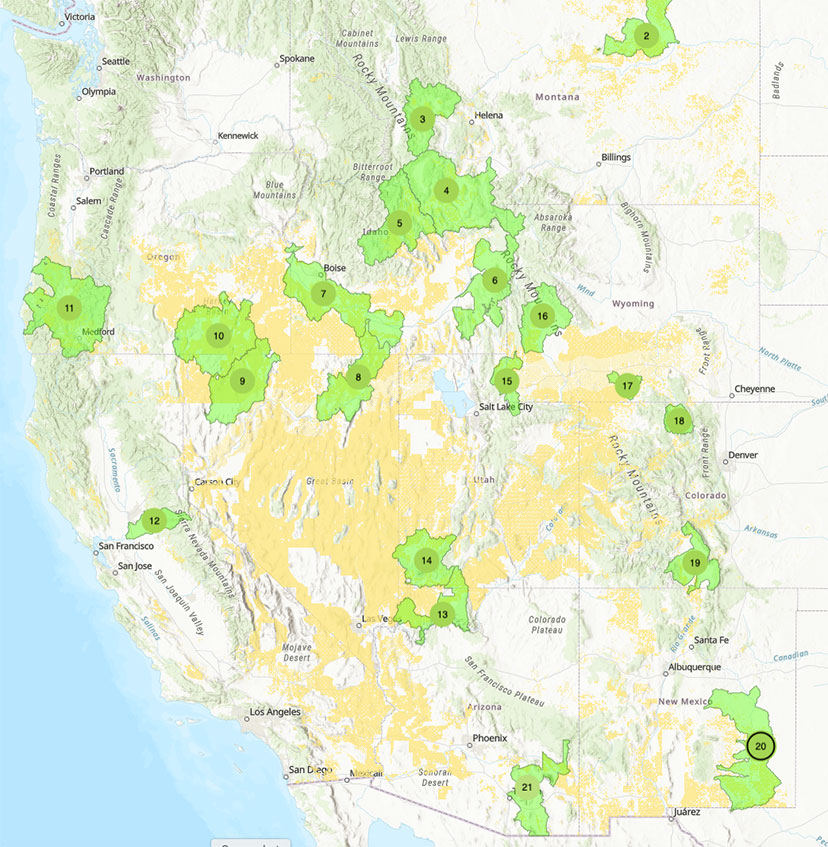Sandhill Cranes, by
The Department of the Interior announced plans, this week, to infuse $161 million into ecosystem restoration and resilience on the nation’s public lands as part of President Biden’s ‘Investing in America’ agenda. This work, led by the Bureau of Land Management, will focus on 21 “Restoration Landscapes” across 11 western states and will range from restoring wildlife habitat in the sagebrush steppe of the high desert to re-creating wetland meadows to repairing watersheds on former industrial timberlands.
Today’s announcement of funding from the Inflation Reduction Act will leverage close to $40 million that the BLM has already deployed from the Bipartisan Infrastructure Law for restoration activities.
“The pressures on our public lands – from invasive species, unprecedented wildfires, drought and increasing use – are being exacerbated by the climate crisis, degrading landscapes and impacting public uses. If we are going to ensure America’s public lands are available to everyone, we must invest in their health,” said Secretary Deb Haaland. “Through the President’s Investing in America agenda, we will increase the ability of public lands to provide clean water, habitat for fish and wildlife, opportunities for recreation, and other important benefits.”
“With today’s investment, we will be able to pass these lands to future generations in better shape than we find them today,” said BLM Director Tracy Stone-Manning. “We’re thrilled to be able to put people to work to benefit wildlife habitat, clean water and the overall health and productivity of our public lands.”
The BLM selected the 21 Restoration Landscapes based on ecological need as well as importance to communities. These areas hold significant potential for additional cross-boundary partnerships and investments from sister federal agencies, state, Tribal and local governments, private landowners and partner groups, which could increase the scope and scale of restoration work.
Two of the 21 project areas are in Colorado.
Area 19 is the San Luis Valley, where critical wetlands and riparian areas provide habitat for numerous birds and federally listed species, in an area sacred to a number of Tribes. Investments in this landscape provide a unique opportunity for the BLM to conserve and restore wildlife habitat and fisheries, improve hunting and fishing opportunities, and foster climate resilience while benefiting historically underserved, disproportionately impacted communities.
Area 18 is North Park, one of the best places to visit and experience core sagebrush habitat and one of the largest wetland complexes in Colorado. At high elevations, these sagebrush communities are more resilient to impacts from a changing climate. The landscape boasts critical winter range and migration corridors for big game and numerous culturally significant sites, including the Northern Ute Trail.
More information about each landscape restoration area can be found at BLM’s StoryMap page.
Work in Restoration Landscapes will be collaborative and partnership-driven, supporting coordinated investments from across the BLM, including the fuels management, range, wildlife, forestry, aquatics and recreation programs. The BLM’s Assessment, Inventory and Monitoring Strategy will be used to monitor outcomes and ensure restoration efforts are successful and durable.
Today’s announcement follows the release of the Department’s restoration and resilience framework to leverage historic investments in climate and conservation to achieve landscape-level outcomes across the nation. The Department is implementing more than $2 billion in investments to restore our nation’s lands and waters, which in turn is helping to meet the conservation goals set through the America the Beautiful Initiative.
As the nation’s largest public lands manager, the BLM has restored millions of acres of public lands. Focusing on Restoration Landscapes allows the BLM to concentrate the new and historic funding provided by these laws to engage in partnerships more efficiently, clearly articulate the agency’s vision for public lands, and multiply the return on restoration investments on behalf the American people.


